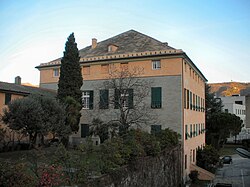Forte Sperone
Buildings and structures in GenoaCity walls in ItalyTourist attractions in Genoa

Forte Sperone is a fortification included in the "New Walls" built to defend the Italian city of Genoa, located on top of Mount Peralto. The union of two walls, one on the side of Val Polcevera and the other on the side of Val Bisagno, gives the fort the appearance of the bow of a ship, from which its name derives. Due to its dominant position, it was one of the most important structures of the fortifications of Genoa.
Excerpt from the Wikipedia article Forte Sperone (License: CC BY-SA 3.0, Authors, Images).Forte Sperone
Via del Peralto, Genoa Centro Est
Geographical coordinates (GPS) Address External links Nearby Places Show on map
Geographical coordinates (GPS)
| Latitude | Longitude |
|---|---|
| N 44.440555555556 ° | E 8.9305555555556 ° |
Address
Forte Sperone
Via del Peralto
16135 Genoa, Centro Est
Liguria, Italy
Open on Google Maps











